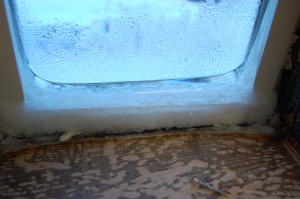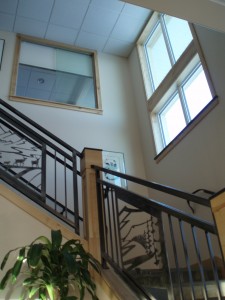Frequently Asked Questions: Windows
What does U-value mean?
U-value, also sometimes referred to as U-factor, is a measurement of the window’s overall effectiveness against heat loss. Lower U-values indicate better insulative properties, and are important for keeping comfortable in Alaska’s cold climate, as described in this video. U-values are typically used to describe the insulation level of windows, doors, and skylights. U-values are simply the inverse of R-values, which are typically used to describe the heat transfer through materials used to insulate walls, floors, and ceilings.
Certified Alaska Tough windows have been tested to have a window assembly U-value of 0.20 or less. To put this into context, Energy Star windows in Northern climates are required to have a U-value of 0.27 or less. The Certified Alaska Tough standard is set at this level because we feel it is the highest level of thermal comfort that can be produced with current technology at a reasonable price. When evaluating window U-values, it is important to distinguish between a window assembly U-value, which includes the framing, and a center of glass U-value, as some companies will try to market using the center-of-glass value as it is generally a better number than the assembly value. The center-of-glass U-value is typically better because components in the frame such as metal spacers generally allow more heat loss than the argon fill between glass panes.
Why is air leakage important?
Air leakage through windows increases energy loss and causes uncomfortable drafts. This leakage is exacerbated by the high wind speeds found in many areas of Alaska. For this reason Certified Alaska Tough windows are required to have a measured air leakage rate of less than 0.1 cfm/ft2 for operable windows and less than 0.04 cfm/ft2 for fixed windows. In comparison, Energy Star rated windows are required to have air leakage rates of less than 0.3 cfm/ft2.
Different styles of window are more or less prone to air leakage, as described in this video. For example, a fixed window will generally be more air-tight, as the weatherstripping is fixed, whereas sliding windows rely on pressure to push the window up against the weatherstripping each time it is closed.
These air leakage ratings only apply to air leakage through the window and window framing. Air infiltration can also occur around the outside of the frame of the window if it has been poorly installed or poorly maintained. CCHRC has a video on how to properly install an air barrier, including the required detailing around a window.
What is the NFRC?
NFRC stands for the National Fenestration Rating Council. The NFRC is a non-profit organization that provides an independent verification of product performance for windows, doors, and skylights. The Certified Alaska Tough label requires that the U-value of a window be NFRC certified.
Any window that has been NFRC certified will come with a label that describes its features. This label includes the ratings for the window’s U-factor, air leakage, solar heat gain coefficient (SHGC) and visible transmittance. For a detailed description of this label, see the NFRC website.
What is the Solar Heat Gain Coefficient and why is it not a part of the Certified Alaska Tough label?
The Solar Heat Gain Coefficient (SHGC) is the fraction of solar radiation admitted through a window. It is a number between 0 and 1; the lower the number, the less solar heat it transmits. A window with a SHGC closer to 1 will transmit most of the solar energy through the window; in the winter, this is beneficial as it provides free heat, in the summer, this additional solar heat gain can cause overheating and increase air conditioning loads. Window manufacturers often add special coatings or films to decrease the SHGC. The need for reduced SHGC is highly variable and can even depend on the direction the window is facing so it is not part of the certified Alaska tough requirements.
What does a “Performance Grade” level mean for windows?
Performance Grades for windows are ratings given based on their ability to withstand wind loads, and resist water penetration due to wind-driven rain. These capabilities are tested based on standard AAMA/WDMA/CSA 101/I.S. 2/A440, jointly published by the American Architectural Manufacturers Association, the Window and Door Manufacturers Association, and the Canadian Standards Association.
The required Performance Grade to receive a Certified Alaska Tough label is 45. This will allow the window to withstand the highest wind load requirement of the International Building Code within Alaska, which is a 3 second gust of 130 miles per hour. It also means that there was no leakage during a water pressure test that blew an equivalent of 53 mph wind-driven rain at the window. These sturdy, durable windows will withstand conditions from the wind-blown arctic coastline to the storms that pass through the temperate rainforest of Southeast islands, which is why they are Certified Alaska Tough.


